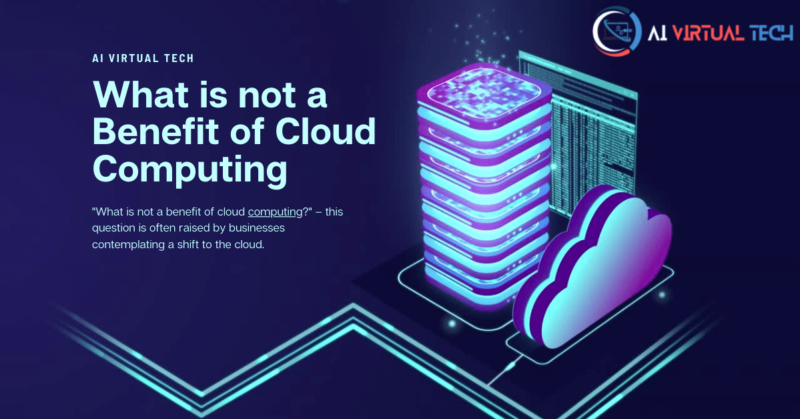“What is not a benefit of cloud computing?” – this question is often raised by businesses contemplating a shift to the cloud. As more companies adopt cloud services, understanding the pros and cons is essential to making informed decisions.
Understanding Cloud Computing
- Cloud computing is the delivery of computing services over the internet, offering scalable resources such as storage, software applications, and processing power.
- It’s touted for its numerous advantages such as cost-efficiency, scalability, and flexibility. However, it isn’t without its possible drawbacks.
- Cloud computing systems are typically highly reliable, but they are not infallible. Downtime can occur due to various reasons such as system failures, network issues, or even a service provider’s inability to handle high demand. Businesses reliant on the cloud can experience significant disruptions during these downtimes.
- While cloud service providers typically have robust security measures in place, the nature of cloud computing can still present security risks.
- Sensitive information stored on the cloud could potentially be exposed during data transfers or due to unauthorized access.
Vendor Lock-in
Vendor lock-in is a common concern among organizations considering a move to the cloud. Being overly dependent on a single cloud provider can limit flexibility and increase vulnerability to price increases or changes in business practices.
The potential challenges that arise when migrating to a different provider can sometimes give us a sense of being ‘trapped’ in our current situation.
It necessitates meticulous planning, allocating sufficient time, and allocating resources to ensure a seamless transition.
From assessing the compatibility of systems to training employees on new processes, every step requires careful consideration to minimize disruptions and maximize the benefits of the migration.
Also, not all services are compatible across different cloud platforms. This interoperability issue can limit the ability of businesses to take full advantage of the cloud’s potential for flexibility and scalability.
Limited Control
- While cloud computing simplifies IT management and reduces the need for in-house IT staff, this simplification often comes with reduced control.
- Companies may not have the same level of access or control over their data as they would with on-premise solutions.
- In a cloud environment, many aspects of the service are managed by the provider. This includes decisions about system updates, server configurations, and security protocols.
- By entrusting these responsibilities to the provider, businesses can focus more on their core operations and strategic initiatives.
- The provider ensures that the latest updates and patches are applied to the system, optimizing performance and minimizing vulnerabilities.
- Moreover, the lack of control can be problematic for businesses in heavily regulated industries. They may find it challenging to ensure that their cloud setups comply with all relevant regulations.
Network Dependency
Cloud computing is heavily dependent on the internet. Without a reliable internet connection, cloud services may be inaccessible, causing disruptions in business operations.
In areas with limited or unreliable internet connectivity, cloud computing may not be the best solution.
For businesses where continuous access to data is crucial, this dependency could pose significant risks.
Furthermore, the quality of the internet connection can also affect the performance of cloud services.
Slow speeds or high latency can lead to less efficient operations, undermining the productivity benefits of moving to the cloud.
Data Privacy Concerns
- Data privacy is an increasingly pressing concern in the realm of cloud computing. This is especially true for businesses that deal with sensitive customer data, as the potential for data breaches looms as a significant downside.
- With the ever-growing reliance on cloud services, it becomes paramount for organizations to implement robust security measures and protocols to safeguard against unauthorized access and protect the privacy of their valuable data assets.
- Failure to do so can have severe consequences, including reputational damage and legal ramifications. Therefore, businesses need to prioritize data privacy and invest in comprehensive security strategies when leveraging the benefits of cloud computing.
- Cloud service providers typically employ robust security measures, but no system is completely immune to breaches.
- Businesses must consider the risks and regulations associated with storing sensitive data on the cloud.
- Furthermore, legal and regulatory requirements regarding data privacy can vary greatly from one region to another. Navigating these complexities can be challenging for businesses operating across multiple jurisdictions.
Scalability Limitations
While cloud computing offers scalability, allowing businesses to easily adjust resources to meet their needs, it is important to note that this scalability is not without its limitations.
In some cases, rapid increases in demand can surpass a provider’s capacity, leading to potential service degradation or even complete outages.
Therefore, it becomes crucial for businesses to carefully consider their scalability requirements and ensure they have contingency plans in place to mitigate any potential risks associated with these limitations.
While cloud providers claim virtually unlimited capacity, the reality is that resources are finite.
During periods of high demand, businesses might not be able to scale their services as quickly or as much as required.
When it comes to scaling down, businesses usually find it relatively straightforward. However, it’s worth noting that depending on their service agreement, they might still encounter additional costs for unused resources.
This is an important consideration that underscores the need for careful planning and resource management to optimize operational efficiency and cost-effectiveness.
Economic Considerations
While cloud computing can offer cost savings, it’s not always the most economical choice. Over time, the recurring costs of cloud services can exceed the one-time cost of purchasing and maintaining on-premise hardware.
The pricing models for cloud services can be complex and unpredictable. Factors such as data transfer costs, number of users, and specific features can significantly impact the overall cost.
This process can require specialized expertise and resources, as well as time and effort to ensure a smooth and seamless transition. Furthermore, training employees to adapt to new cloud-based systems may be necessary to maximize the benefits of cloud computing.
It is important to note that during this transition period, there may be a temporary period of downtime as the new systems are implemented and configured to meet the specific needs of the organization.
Summary
This document explores the critical aspects of cloud computing, highlighting its advantages, risks, and economic considerations. Among the benefits, scalability and accessibility stand out, ensuring businesses can scale their services quickly and access data from anywhere. However, the risks associated with cloud computing include potential security challenges, complexity in transitioning, and potential downtime. Economically, while cloud computing might provide cost savings initially, recurring costs can add up, and the pricing models may be complex and unpredictable.
Frequently Asked Questions (FAQS)
What are the key advantages of cloud computing?
The primary benefits of cloud computing include its scalability and accessibility. Businesses can quickly scale their services as per demand and access their data irrespective of geographical location.
What are the potential risks associated with cloud computing?
Security vulnerabilities stand as a significant risk. The transition process to a cloud-based system can also be complex and time-consuming and may involve a temporary period of downtime.
Are there any economic considerations related to cloud computing?
Yes, the recurring costs of cloud services can eventually surpass the one-time cost of purchasing and maintaining on-premise hardware. Moreover, the pricing models for these services can be complex and unpredictable.
Does transitioning to a cloud-based system require specialized expertise?
Yes, transitioning often requires specialized resources, and expertise, as well as time and effort to ensure a smooth transition. Employees may also need training to adapt to the new systems.
Does cloud computing always offer cost savings?
Not necessarily. Despite initial cost savings, the recurring costs can add up over time, and the pricing models may be complex and unpredictable, which can significantly impact the overall cost.
Conclusion
While cloud computing offers potential benefits such as improved accessibility and scalability, organizations must weigh these advantages against the associated risks and economic factors. A thorough understanding of these aspects can help businesses leverage the advantages of cloud computing most effectively while minimizing potential pitfalls.













